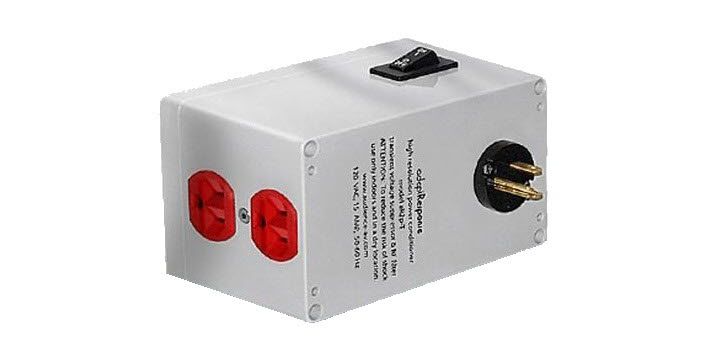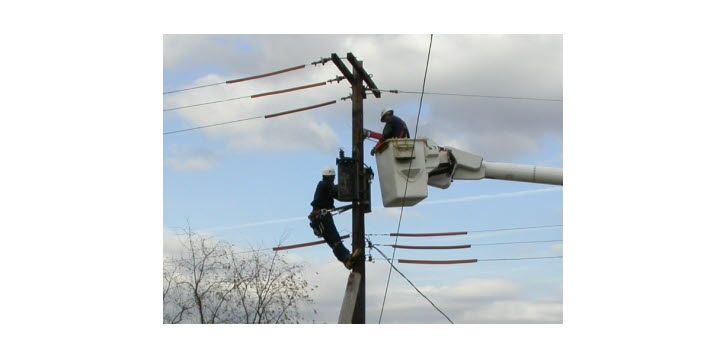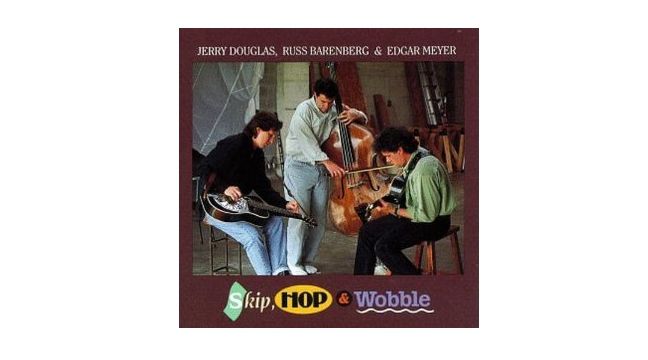“Since the advent of the CD, listeners have been deprived of the full experience of listening.” - Neil Young PonoPlayers...
Read More »
Audience adeptResponse aR2p Power Conditioner Review

I think I have a love/hate relationship with power conditioners. I began buying them in the mid-1990’s, starting with a couple of different models from Tice. Neither had clocks. Perhaps that was the problem with them. Then there was the API Power Wedge. I liked it because it had a big AC meter. I think the next one was the original massive Shunyata Hydra. It came in a big wooden crate and was awe-inspiring. Shunyata doesn’t make products like they used to. Since then I have owned models from Brickwall, Equitech, ExactPower, Furman, PS Audio, SurgeX, and others. Currently, I have a Furman Reference RI-1210 balanced power unit in my main system for front-end components.

To tell the truth, I think my best power upgrade occurred when I talked the electric company into disconnecting me from the transformer serving half a dozen homes in the neighborhood and putting me on a separate one shared only with my next door neighbor. It immediately eliminated some rather significant voltage swings. I’m really glad I didn’t have to pay for that one.

My initial reaction to power conditioners is always the same: I start thinking in terms of all the usual audiophile catch-phrases – blacker blacks, increased dynamics, more air around the instruments, veils lifted, etc. But whenever I need to free up funds for an upgrade, the power conditioner du jour is the first thing to go. I guess in the back of my mind, I have not really been convinced that they were all they are cracked up to be. So it was with some trepidation that I agreed to review the Audience adeptResponse aR2p. John McDonald, President of Audience, was sure this time would be different for me.
The adeptResponse aR2p is Audience’s entry-level model. Costing $695, it is a two outlet affair that plugs directly into the wall socket, thus eliminating the need for yet another expensive power cord. It was just the ticket for me. It is not current-limiting, so I could plug both of my Meridian DSP5500s digital active speakers into it without fear of choking the four power amplifiers inside each of them. If you need more outlets, but don’t want to spring for one of Audience’s top-of-the-line models, they recommend using a plain power strip with no switches, filters or surge protection like the Wireworld Matrix MkII. The trade-off is that the additional outlets are not isolated from one another as in Audience’s upper-echelon offerings.
It is evident at first glance that Audience elected to spend money on component parts and not on aesthetics. If you are looking for something made from billet aluminum, then you need to look elsewhere – and be prepared to pay for it. The aR2p is functional. Its enclosure is made of gray high impact polycarbonate, though, from a distance, it does sort of look like metal. Works for me. Just tuck it away behind your rack so you don’t lose face with your audiophile buddies. Nevertheless, the AC plug, Hubbell hospital grade AC sockets, 15 amp magnetic circuit breaker, and on/off switch are all of high quality. The unit provides surge protection, power factor correction, and wide-bandwidth RF noise filtering using audiophile grade Auricap precision wound metalized film capacitors. (An upgraded unit employing Aura-T Teflon capacitors is available for $1600). Audience eschews MOVs (metal oxide varistors) found even in some ultra-expensive units in favor of non-sacrificial surge protection. RF noise filtering is key as we will see.
Okay, so I know you want to know how it sounds. Well, patience is a virtue. John advised me that it requires 100 hours or so of break-in for the capacitors to properly form. So I just plugged my DSP5500s into it and didn’t give it another thought for a couple of weeks. It seemed like a good plan. Lots of times you don’t notice changes until you take a component out of the system anyway. I wondered if that would be the case this time.
Here’s a truth. You cannot do an instantaneous A/B comparison of power conditioners. You need to listen to a musical selection, turn off your components, switch all component power cords between the first and second power conditioner, turn your components back on, and then listen again. Some would say you need to let your components warm back up. Others would say you need to wait a week or two while your cables settle in again. A few would even say you need to wait a month or so while the contacts re-oxidize. Regardless of where you fall along that spectrum, time will elapse between the comparisons. The best you can do listen carefully and take notes. It won’t eliminate expectation bias or the placebo effect, or any of the other seven deadly sins the DBT crowd warns against, but at least you’ll have something to hang your hat on.
The first listening test I performed was to crank the gain all the way up on my Meridian DSP5500s and put my ear up to the tweeter. I noticed a very, very faint hiss. It was almost inaudible, a testament to the quietness of the feed from my music server through the Halide Design USB-S/PDIF bridge, as well as the amplifiers in my DSP5500s. I jotted that down on my scorecard.
Regular readers will remember that I play guitar in a bluegrass group. My good friend Tom, who plays a custom dobro with an exquisite tone, is usually on my right. I am intimately familiar with its sound. Sharp attacks and slides with both a woody and metallic resonance. For an audio system, it supplies a tough test of both the midrange and treble, and, importantly, transient response. As Alison Krause puts it, Jerry Douglas is the greatest dobro player the world has ever known. Few disagree. So I pulled out my copy of Skip, Hop & Wobble on which Jerry joins legends Russ Barenberg on guitar and Edgar Meyers on bass. The cuts I focused on were Big Bug Shuffle, Why Don’t You Go Back to the Woods, and From Ankara to Izmir.

I listened first with the adeptResponse aR2p in the system since that is what I had grown accustomed to. I then unplugged the adeptResponse aR2p and listened again. Finally, I plugged the adeptResponse aR2p in and listened a third time. This is where your typical reviewer will say that he instantly heard a dramatic night and day difference, or that his wife came running in from the kitchen breathlessly asking what he had changed. The changes I heard were not of the dramatic night and day variety; they were subtle and became apparent only after careful listening.
The adeptResponse a2Rp did not add an extra octave of bass, warm up the midrange, or extend the high frequency response. It also did not change the timbre of the instruments, or widen or deepen the soundstage. If I had to sum up the difference between the music with and without the adeptResponse aR2p in one word, it would be this: clarity. The instruments appeared better separated across the soundstage and the individual notes of the instruments sounded more distinct. The transients of the notes on the dobro were more sharply defined, and the slides more metallic, as they are during a live performance. With the guitar, you could better hear the sound of the pick on the string, and with the bass the sound of the scrape of the bow. Even the breathing sounded clearer. Again, subtle but important differences, the net effect of which was to render the performers more present in the room and the sound more like that of live music.
Before concluding my listening session, I once again cranked the gain all the way up on my Meridian DSP5500s and put my ear up to the tweeter. The very, very faint hiss I had initially heard was more pronounced without the adeptResponse aR2p, though I still could not hear it from the listening position. I believe the reduction of noise with the adeptResponse aR2p is what gave the music greater clarity. Perhaps more is going on, but this seems to me to be the most reasonable explanation.
Conclusion
For the budding audiophile purchasing his first entry-level system ($3000-$5000), my recommendation is that you purchase your core components – source, amplification, speakers - first. I would rather see you initially allocate the $695 cost of the adeptResponse aR2p to a better pair of speakers. The audible return on investment will be much greater. Become familiar with the sound of your new system over several months before contemplating your next purchase knowing that audio systems do not remain stagnant. Future areas to explore are cables and power conditioners. Well chosen, both will offer a noticeable level of refinement to the reproduction chain once the core of your system is taken care of; however, their contribution is not something you are likely to appreciate right out of the starting gate.
That being said, I would place the adeptResponse aR2p at the top of my list of next purchases, even ahead of interconnects and speaker cables. It is reasonably priced and will serve you well through several future rounds of upgrades. If you need more outlets, simply add a high quality power strip like the Wireworld Matrix MkII. Or you could just throw your budget out the window, buy it, and enjoy its benefits from the get-go. I think, unlike other power conditioners that have passed through my system, I will be keeping the adeptResponse aR2p for the long term. Listening tests aside, just knowing that the low-level hiss is gone gives me a certain peace of mind. Now I can worry about other stuff.
- Frank Berryman
For more information on the design and performance of the Audience adeptResponse aR2p and other Audience products, be sure to read my interview with John McDonald, President of Audience, LLC, here.
Contact Information
Audience, LLC
120 N. Pacific Street #K-9
San Marcos, CA 92069
(800) 565-4390
http://www.audience-av.com
[email protected]
Associated Equipment
Digital Source: Windows 7 music server with ESI Juli@ soundcard; Halide Design Bridge
Preamplifier: Meridian G68ADV
Loudspeakers: Meridian DSP5500
Cables: Digital: Meridian; Power: Volex/Marinco
Headphones: Etymotic ER-4S
Accessories: GIK acoustic treatments; dedicated 20 amp circuit; Audience adeptResponse aR2p

